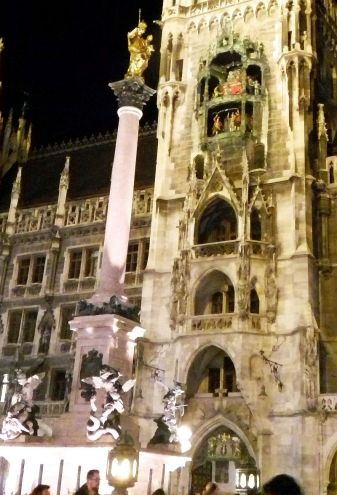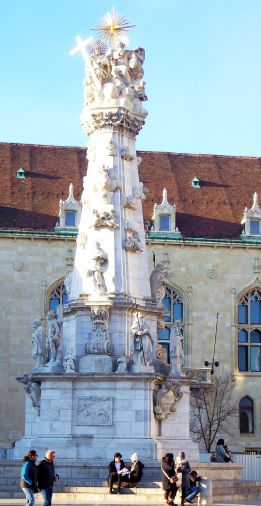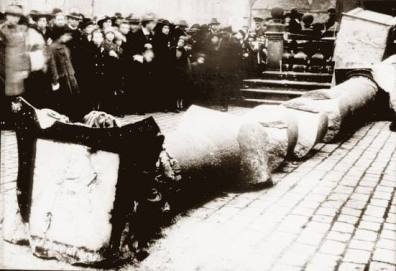LINZ
I had never heard of Plague Columns (‘Pestsaule’ in  German) until I crossed over the border from Germany into Linz in Austria and encountered one in the main square of this major town on the Danube River. In encountering marble columns in city squares, I would normally assume they were war memorials, particularly erected after World War I and generally added to after 1945. In the case of the marble column in Linz’s main square, it is a much older public construction pointing at the heavens, more an action of thanksgiving than memorial. It is a thanks for deliverance from past tribulations such as the usual perils of fire, pestilence and war. War memorials are usually civic monuments, generally of austere shape in keeping with their memorial purpose. Plague columns such as the one in Linz is both religious in intent and flamboyant in its artistry. Beauty encased in gold sheeting seems to be what is called for when you are giving thanks for escaping the violent ghastly deaths that afflicted your neighbours.
German) until I crossed over the border from Germany into Linz in Austria and encountered one in the main square of this major town on the Danube River. In encountering marble columns in city squares, I would normally assume they were war memorials, particularly erected after World War I and generally added to after 1945. In the case of the marble column in Linz’s main square, it is a much older public construction pointing at the heavens, more an action of thanksgiving than memorial. It is a thanks for deliverance from past tribulations such as the usual perils of fire, pestilence and war. War memorials are usually civic monuments, generally of austere shape in keeping with their memorial purpose. Plague columns such as the one in Linz is both religious in intent and flamboyant in its artistry. Beauty encased in gold sheeting seems to be what is called for when you are giving thanks for escaping the violent ghastly deaths that afflicted your neighbours.
MUNICH
I discovered that Plague Columns were also called Marian or Holy Trinity Columns as not only were they enduring prayers of thanks for the end of plague tours, they were also a general expression of the religious beliefs of the Catholic Countries that made up much of the old Hapsburg Empire. These columns were always decorated with images of Mary or the Holy Trinity at the top and other saints gathered at the base. One saintly example would be St Lawrence, the ‘many arrowed’ martyr of the Romans. (The plague was often represented as random, like falling arrows.) One of the earliest examples of the Marian Column that had been built as thanksgiving for the passing of war and its associated plague we had already encountered when we had strolled through the Marienplatz (Mary’s Square) of Munich. Overshadowed today by the Rathaus, the Marian Column was built in 1638, a few years after Munich had been invaded by a Swedish Army which was then followed by the ravages of the Bubonic plague which killed off about one third of the population.
that made up much of the old Hapsburg Empire. These columns were always decorated with images of Mary or the Holy Trinity at the top and other saints gathered at the base. One saintly example would be St Lawrence, the ‘many arrowed’ martyr of the Romans. (The plague was often represented as random, like falling arrows.) One of the earliest examples of the Marian Column that had been built as thanksgiving for the passing of war and its associated plague we had already encountered when we had strolled through the Marienplatz (Mary’s Square) of Munich. Overshadowed today by the Rathaus, the Marian Column was built in 1638, a few years after Munich had been invaded by a Swedish Army which was then followed by the ravages of the Bubonic plague which killed off about one third of the population.
The Plague or the Black death seems to have originated in the dry desert plains of China and had eventually reached Europe in the 1340s. The Great Silk Road was the route the plague took on its journey to Europe. Trade goods arrived in Crimea and from there the products of Cathay and the associated infected rats sailed on to the rest of the world. The vehicle for the transmission of the disease was a bacterium, Yersinia Pestis, which occurred in mosquitoes. The mosquitoes were hosted by rodents and other small animals which carried the plague bacteria on their foreign journeys. Appropriate treatment for the plague was not developed until the late 19th century, particularly the importance of sanitary living conditions. Today the disease can be easily treated with antibiotics but the bacterium still exists and there are still outbreaks around the world today, the last one appears to have been in Madagascar in 2017 where 170 people were reported as having died from the plague.
In this highly scientific age of the new Millennium, citizens are no longer calling for Plague Columns to be raised to the heavens in city squares to either prevent an outbreak of the Plague or to thank God for its departure. The use of the arrow in flight as a symbol for the inexplicable arrival of the plague has usually meant that people looked to the arbitrary heavens for answers. The religious background of Europe in the Middle Ages meant the inexplicable descent of horrendously painful deaths meant something or someone was to blame. In the search for blame, there were two answers that were almost as deadly as the plague. One was to blame ‘ourselves’. One peculiar response from this angle was the rise of the Flagellant movement in northern Italy where citizens decided they were so sinful that God was punishing them by sending the plague. The consequence was to get in early and assist the process by wondering from town to town in groups, flogging themselves along the way. The second response was to blame other people who weren’t like the rest of us; Jews, friars, foreigners, beggars, pilgrims, lepers and Romani. By 1351, 60 major and 150 smaller Jewish communities had been destroyed in Europe.
VIENNA


The most famous Plague Column and the inspiration for many others set up in other towns and cities in Central Europe is the Pestsaule or Holy Trinity column in the Grabenplatz of Vienna. This column stands on the tourist route between the old Hapsburg Palace and St Stephens Cathedral and is an overwhelming sight that towers above the pedestrians. One travel writer describes it as a “huge gilded, baroque confection of a sculpture” and another comments that the “column has entirely disappeared in marble clouds and colossal saints, angels and putti (cherubs)”. It was so ornate and eccentric in its display that when I encountered it, I had to walk around its base a few times to interpret the message it might be sending upwards to the Holy Trinity.
The plague had been wandering around and into Vienna ever since its arrival in Europe in the 14th century. However what was called the ‘Great Plague of Vienna’ occurred in 1679 and estimates of the dead amount up to 80,000 citizens. There were a few reasons why Vienna was a sitting duck for the Plague. It was on the trade routes from the east, particularly for goods shipped up the Danube from the Black Sea. If the Plague travelled the Great Silk Road, it was definitely going to come up the Danube. The other issue is that the Plague loves an unhygienic city. Vienna of the late 1700s had no sewerage or drainage systems and like the rest of the cities of Europe, had no garbage disposal system. It was also a city of trade warehouses where organic materials were stored for long periods, the perfect home for rats. Vienna needed more than the Plague Column that King Leopold I had ordered built to protect his city from the roaming, ravaging Bubonic Plague when the disease visited the packed houses of Vienna. The Pestsaule was finished in 1693, well after the crisis had passed and the city had also survived the second siege of the city by Ottoman armies.
Life went on in Vienna into the troubled years of the 18th century and while the plague had subsided, the Hapsburg Empire was still afraid for its future from foreign invasions. There was no male heir to the throne and Emperor Charles VI took a risk in believing that his eldest daughter Maria Theresa would be the future monarch who would save his empire from his neighbours’ armies. He was right to do so. In the image below from 1740, a pregnant Maria Theresa is passing the Holy Trinity Column in the Grabenplatz on her way to hear High Mass at St Stephen’s Cathedral before receiving homage from her subjects.

BUDAPEST
I was not expecting to encounter  another Plague Column when we moved on to Budapest where we spent four days. On the first afternoon of our arrival we were taken on a bus tour up the Buda Hill to inspect the old defensive area of the city where the old castle was. We were dropped off for a walk to inspect the very beautiful St Matthias Church and this church hadn’t come into view when I saw a familiar column in the distance with the Holy trinity symbols on the top and the attendant saints around the bottom. The plague had arrived in Buda in the early 1690s and the foundation stone was laid in 1700. Before the original plague column could do its work, the plague returned again to Buda. The column I first saw from a distance like an old friend was the redesigned column that was finally finished in 1713.
another Plague Column when we moved on to Budapest where we spent four days. On the first afternoon of our arrival we were taken on a bus tour up the Buda Hill to inspect the old defensive area of the city where the old castle was. We were dropped off for a walk to inspect the very beautiful St Matthias Church and this church hadn’t come into view when I saw a familiar column in the distance with the Holy trinity symbols on the top and the attendant saints around the bottom. The plague had arrived in Buda in the early 1690s and the foundation stone was laid in 1700. Before the original plague column could do its work, the plague returned again to Buda. The column I first saw from a distance like an old friend was the redesigned column that was finally finished in 1713.
Plague hasn’t been the only dangerous marauder to seek to destroy Buda. The photo below was taken in 1945 showing a bedraggled Holy Trinity Column still standing proud in the ruins of the bombed Holy Trinity Plaza of Budapest.

 The ruins of Holy Trinity Square, Prague in 1945. On the right, the Marian Column pulled down in the old Town Square of Prague in 1918.
The ruins of Holy Trinity Square, Prague in 1945. On the right, the Marian Column pulled down in the old Town Square of Prague in 1918.
PRAGUE
I have called this article about my encounters with Central European Plague Columns… ‘PLAGUE COLUMNS; The Intersection of great Art, great Misery and great Piety!’ I should change the title when I come to discuss the ‘Missing’ Marian Column of Prague; ‘Plague Columns; The Intersection of great Art, great Misery, great Piety and HISTORY!’ There is no Column in the Old Town Centre of Prague today where you would expect to see it. It was there, built in 1652, but three years after the construction of the Hus monument nearby in the square in 1918, a mob of nationalists celebrating the declaration of Czechoslavakian Independence pulled it down. It was seen as the key symbol of the oppression of the Bohemian people by the Catholic, Hapsburg empire. Its purpose was to celebrate victory over Sweden in the Thirty Year war in 1650. It was 14 metres high, a gold-plated Virgin Mary on top and four angels at the base fighting against the forces of evil,  presumably Swedish troops, not local Hussite citizens.
presumably Swedish troops, not local Hussite citizens.
Curiously, in 2013 there was a plan developed by the city council to revitalize the Old Town Square of Prague and restore the Marian Column (already sculpted and ready to go!). The argument was that “the statue of Jan Hus, representing Protestantism, and the statue of the Virgin Mary, as a symbol of Catholicism, could stand side by side – would show that Prague is truly a city of the third millennium, where differing world views and religious views can naturally co-exist.” History apparently moves in circles but this circle hasn’t closed yet, the Marian Statue wasn’t there when we visited in November 2018.
CESKY KRUMLUV
We also took the opportunity to visit Cesky Krumlov during our time in the Czech Republic and it was no surprise to encounter another Marian plague column in the town square of this lovely town that shares the Vlatava River with Prague, albeit a lot further up stream. The Black Plague had visited the town in the early 1680s and this column was finished in 1716. Rather than having angels to assist the Virgin Mary secure the defences of Cesky Krumlov, this monument has asked some of the towns favourite saints to weigh into the process. Apart from the usual St Sebastian, two of Bohemia’s favourite saints that are proudly celebrated in Prague’s Basilica, St Wencelaus and St Vitus, are present. This is a worthy team to call upon to defend this wonderful village.
OLOMOUC
Considered to be one of the last and the grandest Plague Monuments is the Holy Trinity column in the town of Olomouc in the Czech Republic. A mark of its status was that in “2000 it was inscribed on the UNESCO World Heritage List as one of the most exceptional examples of the apogee of central European Baroque artistic expression” (Wikipedia). It was a memorial of the visitation of the plague between 1715-1717. When it was finally finished, Empress Maria Theresa visited with her husband to celebrate its official opening in 1754. Four years later, Olomouc was besieged by a Prussian army and the frightened but outraged local citizens demanded of the Prussian General that he spare their extraordinary column. He did and to mark this curious incident, there is a gilded cannon ball stuck in the column to this day. This Plague Column was doing some of its job in defending the citizens of Olomouc! However the column itself was demanding of its sculptors; four of those working on the column died in the process of its construction.


Before arriving in Linz Austria, I knew nothing of Plague Columns and their reflection of the tortured history of central Europe in the Middle Ages. There is something uniquely human about the need to erect columns to the heavens to remember the local victims of war and the plague, hoping these aerials of divine communication might be a barrier to future visitations from nasty unwelcome guests of all forms. It speaks to and from the heart of the human condition, ordinary people shocked by the gratuitous violence of everyday life as well as hoping and praying for reasonable answers to the unreasonable and unbearable circumstances forced upon them.